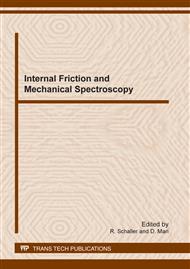[1]
L.B. Magalas, Determination of the logarithmic decrement in mechanical spectroscopy, Sol. St. Phen. 115 (2006) 7-14.
Google Scholar
[2]
L.B. Magalas, M. Majewski, Recent advances in determination of the logarithmic decrement and the resonant frequency in low-frequency mechanical spectroscopy, Sol. St. Phen. 137 (2008) 15-20.
DOI: 10.4028/www.scientific.net/ssp.137.15
Google Scholar
[3]
L.B. Magalas, T. Malinowski, Measurement techniques of the logarithmic decrement, Sol. St. Phen. 89 (2003) 247-260.
DOI: 10.4028/www.scientific.net/ssp.89.247
Google Scholar
[4]
L.B. Magalas, M. Majewski, Ghost internal friction peaks, ghost asymmetrical peak broadening and narrowing. Misunderstandings, consequences and solution, Mater. Sci. Eng. A 521-522 (2009) 384-388.
DOI: 10.1016/j.msea.2008.10.073
Google Scholar
[5]
L.B. Magalas, A. Stanisławczyk, Advanced techniques for determining high and extreme high damping: OMI – A new algorithm to compute the logarithmic decrement, Key Eng. Materials 319 (2006) 231-240.
DOI: 10.4028/www.scientific.net/kem.319.231
Google Scholar
[6]
L.B. Magalas, Snoek-Köster relaxation. New insights – New paradigms, J. de Phys. IV, 6 (C8) (1996) 163-172.
DOI: 10.1051/jp4:1996834
Google Scholar
[7]
L.B. Magalas, Mechanical spectroscopy – fundamentals, Sol. St. Phen. 89 (2003) 1-22.
Google Scholar
[8]
I. Yoshida, T. Sugai, S. Tani, M. Motegi, K. Minamida, H. Hayakawa, Automation of internal friction measurement apparatus of inverted torsion pendulum type, J. Phys. E: Sci. Instrum. 14 (1981) 1201-1206.
DOI: 10.1088/0022-3735/14/10/024
Google Scholar
[9]
D. Agrež, A frequency domain procedure for estimation of the exponentially damped sinusoids, 12 MTC: 2009 IEEE Instrumentation and Measurement Technology Conference, 1-3 (2009) 1295-1300.
DOI: 10.1109/imtc.2009.5168660
Google Scholar
[10]
K. Duda, L.B. Magalas, M. Majewski, T.P. Zieliński, DFT-based estimation of damped oscillation parameters in low-frequency mechanical spectroscopy, IEEE Transactions on Instrumentation and Measurement, 60 (2011) 3608 - 3618.
DOI: 10.1109/tim.2011.2113124
Google Scholar
[11]
J. Rubianes, L.B. Magalas, G. Fantozzi, J. San Juan, The Dislocation-Enhanced Snoek Effect (DESE) in high-purity iron doped with different amounts of carbon, J. de Phys. 48 (C-8) (1987) 185-190.
DOI: 10.1051/jphyscol:1987825
Google Scholar
[12]
L.B. Magalas, A. Piłat, Zero-Point Drift in resonant mechanical spectroscopy, Sol. St. Phen. 115 (2006) 285-292.
DOI: 10.4028/www.scientific.net/ssp.115.285
Google Scholar
[13]
L.B. Magalas, J.F. Dufresne, P. Moser, The Snoek-Köster relaxation in iron, J. de Phys. 42 (C-5) (1981) 127-132.
DOI: 10.1051/jphyscol:1981519
Google Scholar
[14]
S. Etienne, S. Elkoun, L. David, L.B. Magalas, Mechanical spectroscopy and other relaxation spectroscopies, Sol. St. Phen. 89 (2003) 31-66.
DOI: 10.4028/www.scientific.net/ssp.89.31
Google Scholar
[15]
L.B. Magalas, S. Gorczyca, The Dislocation-Enhanced Snoek Effect – DESE in iron, J. de Phys. 46 (C-10) (1985) 253-256.
DOI: 10.1051/jphyscol:19851057
Google Scholar
[16]
L.B. Magalas, P. Moser, I.G. Ritchie, The Dislocation-Enhanced Snoek Peak in Fe-C alloys, J. de Phys. 44 (C-9) 645-649. a b c d Fig. 1. The values computed for 100 free decaying oscillations (d = 5×10-4, = 1. 12345 Hz, = 1 kHz, S/N= 32 dB) according to different methods: OMI, YM, YMC, A, and Y. Dispersion in decreases with increasing the length of free decaying oscillations in a different way for different methods. (Note the strong dispersion for the Yoshida method, Y. ) a b c d Fig. 2. Variation of the minimal and the maximal relative errors of Young's modulus (E~) as a function of the length of analyzed signals for the OMI, YMC, and Y methods (a, b) and the OMI, YM, and A methods (c, d). a b c Fig. 3. Variation of computed values of the resonant frequency (a) and the relative error of Young's modulus (E~) (b) for the OMI method and DFT methods: DFTL and DFTLC. (Note that points obtained from the DFTL method are outside the scale of Figs. 3a and 3b). Fig. 3c. The minimal and maximal relative errors of the Young modulus for the OMI method and the values obtained from the DFTLC method for 100 free decaying oscillations. (Note that points obtained from the DFTL method are outside the scale of Fig. 3c).
Google Scholar


